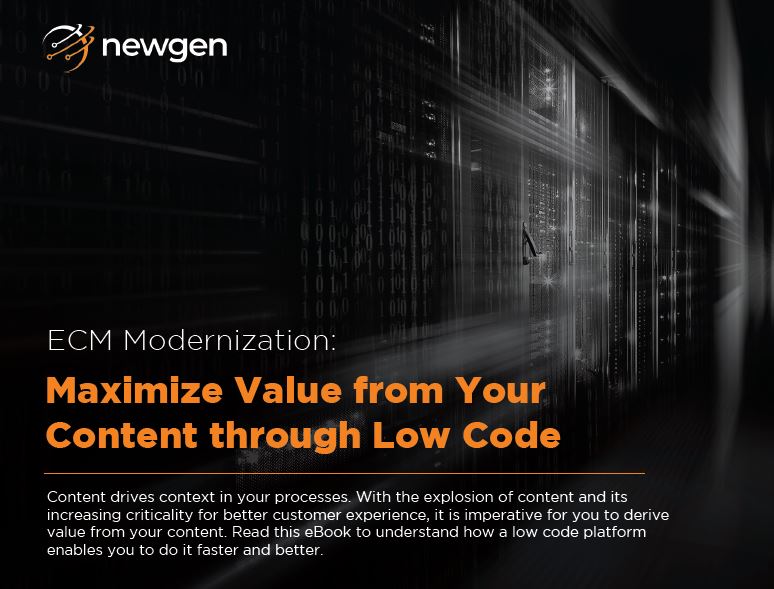Why ECM Modernization Matters More Than Ever?
In today’s digital economy, content is the lifeblood of every enterprise. Yet, most organizations continue to treat it as a byproduct rather than a strategic asset. IDC predicts that by 2025, 80 percent of enterprise data will be unstructured — emails, documents, videos, chat logs, and more.
Unfortunately, much of this content remains locked away in silos, scattered across multiple repositories and legacy ECM systems. The result? Slow decision-making, poor collaboration, and rising compliance risks.
To stay competitive, enterprises must modernize their ECM systems and embrace low-code platforms that allow them to integrate content seamlessly into business workflows, automate processes, and deliver contextual customer experiences — faster and smarter.
The New Content Reality
Employees spend an average of 250 hours each year searching for information across disconnected content systems. This inefficiency not only drains productivity but also increases operational costs.
The challenge lies in:
- Managing exponentially growing volumes of content.
- Extracting meaningful insights from unstructured data.
- Integrating content into business processes in real time.
A modern ECM strategy must go beyond storage and retrieval — it must enable real-time content utilization to enhance business agility and customer engagement.
The Low-Code Advantage in ECM Modernization
According to Gartner, by 2024, more than 65 percent of application development will rely on low-code technologies. This shift is revolutionizing how enterprises build, deploy, and manage content-centric applications.
A low-code digital transformation platform combines visual modeling, prebuilt connectors, and automation to help organizations:
- Rapidly build and modify applications.
- Integrate content services into workflows effortlessly.
- Enable business users and developers to collaborate seamlessly.
- Ensure faster innovation without extensive coding.
This approach allows enterprises to deliver contextual, agile, and intelligent content experiences — all while reducing IT dependency and time to market.
Four Ways to Maximize Content Value with Low Code
1. Accelerate Content Integration through APIs and Web Services
Modern content services expose all ECM functionalities — from document creation to intelligent search — as APIs. This enables smooth integration of content into business applications, eliminating silos.
Key benefits:
- Rapid integration using ready-to-consume APIs.
- Simplified content lifecycle management via visual dashboards.
- Secure and seamless access to content across departments and devices.
By adopting this model, organizations empower teams to work collaboratively and ensure content flows wherever it’s needed — securely and instantly.
2. Build Content-Centric Applications Rapidly
Low-code platforms enable visual, drag-and-drop development of applications integrated with content and workflows. Developers and business users can build solutions collaboratively, improving agility and reducing development cycles.
What this means for your business:
- Accelerated delivery of customer-facing and internal applications.
- Reusable templates and prebuilt components for faster configuration.
- Reduced reliance on IT while maintaining governance and control.
Forrester notes that low-code techniques help enterprises deliver solutions up to 10 times faster, giving them a competitive edge in today’s fast-paced markets.
3. Leverage Analytics and Automation for Intelligence and Speed
Intelligent automation is the next frontier in ECM modernization. By combining content analytics, AI, RPA, and ML, enterprises can extract insights from documents, images, and videos — all in real time.
Key outcomes:
- Faster decision-making through contextual data analysis.
- Automated document classification and metadata extraction.
- Reduced operational costs through hyperautomation.
Gartner predicts that by 2024, organizations will cut operational costs by 30 percent through hyperautomation technologies — a trend that’s reshaping how enterprises handle content-driven workflows.
4. Streamline Development with Agile and CI/CD Mechanisms
Content services can drive continuous innovation through built-in agile and DevOps practices. Low-code platforms allow teams to develop, test, and deploy applications iteratively, ensuring faster go-to-market delivery.
Core enablers:
- Centralized asset libraries for reuse across business applications.
- Preconfigured templates and reusable components.
- Agile development methodologies for quick, iterative innovation.
In the long term, enterprises adopting composable architectures and low-code technologies will lead the way in building adaptable, future-ready ecosystems.
Maximize Value with Newgen’s Low-Code Digital Transformation Platform
Newgen’s digital transformation platform unites process automation, content services, and communication management in a single low-code environment. It empowers enterprises to build and deploy complex, content-driven business applications on the cloud with agility and speed.
Key Capabilities:
- Seamless integration of process, content, and communication workflows.
- Cloud-native, scalable architecture for enterprise-grade performance.
- AI- and ML-powered automation for contextual decision-making.
- Robust security and governance framework for compliance.
With Newgen, enterprises can bridge silos, accelerate innovation, and ensure continuous improvement — transforming content into actionable intelligence.
Newgen’s Contextual Content Services
Newgen’s contextual content services platform is designed to manage the entire content lifecycle, from creation to archival, while enhancing customer engagement and compliance.
Core Features:
- Unified digital workplace: Access and manage content across repositories via a single interface.
- Contextual automation: Drive process efficiency with personalized, content-aware workflows.
- Content intelligence: Utilize AI for data extraction, document classification, and sentiment analysis.
- Compliance management: Maintain complete control over security and regulatory standards.
By combining intelligent automation with content analytics, Newgen helps organizations turn content chaos into competitive advantage.
Building the Future of ECM
ECM modernization is not just about replacing outdated systems — it’s about reimagining how content powers business transformation.
Low-code platforms are enabling enterprises to:
- Deliver smarter, faster customer experiences.
- Automate content-heavy processes end-to-end.
- Scale operations securely and efficiently on the cloud.
- Drive continuous innovation through agility and integration.
In a world where information is growing exponentially, modern ECM is no longer a choice — it’s a necessity.
Transform Your Content Strategy with Newgen
Unlock the full potential of your enterprise content with Newgen’s low-code ECM modernization platform. Build connected, intelligent, and compliant ecosystems that evolve with your business.

